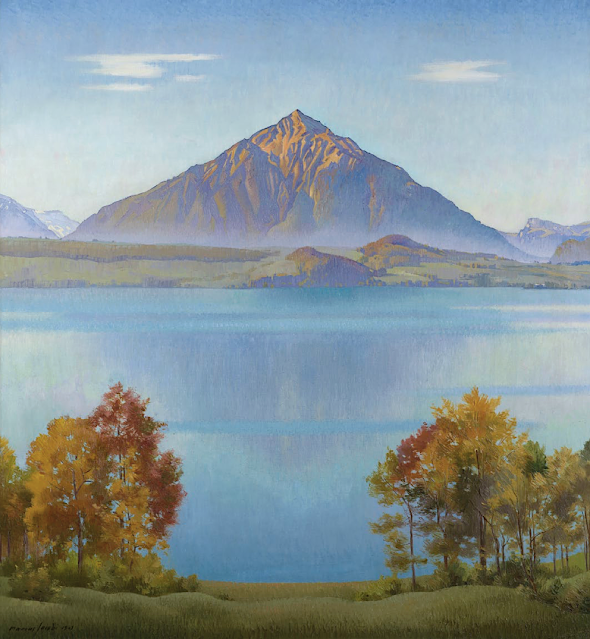-Capolago-maloja,-Corvatsch,-tempo-grigio.jpg)
GIOVANNI GIACOMETTI (1868-1933),
Piz Corvatsch (3 451 m)
Suisse (Grisons)
In Capolago maloja, Corvatsch,
La montagne
Le Pic Corvatsch (3 451 m)
est une montagne de la chaîne des Alpes de la Bernina, surplombant le
lac de Sils et le lac de Silvaplana dans la région de l'Engadine, Canton
des Grisons en Suisse. C'est le point culminant du massif séparant la
vallée principale de l'Inn du Val Roseg. Outre le Piz Corvatsch, deux
autres sommets légèrement inférieurs composent le massif du Corvatsch :
le Piz Murtèl (3 433 m (11 263 ft) ; au nord du Piz Corvatsch) et le
sommet sans nom où se trouve la station supérieure du téléphérique du
Corvatsch (3 303 m (10 837 ft) ; au nord du Piz Murtèl). Politiquement,
le sommet du Piz Corvatsch est partagé entre les communes de Sils im
Engadin et Samedan, bien que le sommet de 3 303 m se situe entre les
communes de Silvaplana et Samedan.
Plusieurs glaciers se trouvent du
côté est du massif. Le plus grand, en dessous du Piz Corvatsch,
s'appelle Vadret dal Murtèl. Le deuxième plus grand, en dessous du Piz
Murtèl et de la gare, s'appelle Vadret dal Corvatsch.
Le téléphérique
du Corvatsch démarre au-dessus du village de Surlej, à l'est de
Silvaplana et culmine à 3 298 m. De là, le sommet du Piz Corvatsch peut
être atteint en traversant le Piz Murtil. En hiver et au printemps, la
montagne fait partie d'un domaine skiable parmi les plus hauts de Suisse
et des Alpes orientales.
Le peintre
Giovanni Giacometti était
un peintre suisse, le père du célèbre peintre et sculpteur Alberto
Giacometti, et de Diego Giacometti, le designer de meubles ainsi que le
père de l'architecte Bruno Giacometti ! En 1886, il étudie la peinture à
l'École des arts décoratifs de Munich, où il rencontre Cuno Amiet
l'année suivante. Tous deux décident de poursuivre leurs études à Paris,
en octobre s'inscrit à l'Académie Julian, où Giacometti reste jusqu'en
1891.
En 1893, peu après son retour en Suisse, à Bergell, il se lie
d'amitié avec Giovanni Segantini, son aîné de dix ans, qui a une grande
influence sur son œuvre en l'ouvrant à la beauté des paysages
montagnards et aux règles du divisionnisme. Après sa mort subite en
1899, Giacometti rencontre Ferdinand Hodler, qui lui apprend à créer une
composition rigoureuse et ornementale par une utilisation appropriée
des formes et des couleurs.
Il voit régulièrement Cuno Amiet qui,
après un an passé à Pont-Aven, lui fait part de son expérience. En 1900,
il expose au Pavillon suisse de l'Exposition universelle de Paris. A
partir de 1905, Giacometti travaille à nouveau dans une grande
complicité avec Amiet et commence à s'affranchir de l'influence de
Segantini. En 1906, a organisé une exposition de son travail au
Kunstlerhaus de Zurich. En 1907, il se rend à Paris avec Amiet pour la
rétrospective Cézanne au Salon d'Automne. Ils copient toutes les oeuvres
de Van Gogh. En 1908, il expose avec les Fauves français à la galerie
Richter de Dresde.
En 1909, la galerie Tannhauser présente ses œuvres
à Munich. Il rencontre Alexi von Jawlensky, et en 1911 participe à la
Sécession de Berlin. En 1912, Giacometti fait une exposition personnelle
au Kunsthaus de Zurich et présente deux œuvres au Sonderbund de
Cologne. En 1918, après la mort de Hodler, il commence à s'impliquer
dans le monde politique suisse en y jouant un rôle important en tant
qu'artiste engagé, à la suite en cela de son ami Amiet.
______________________________________
2025 - Gravir les montagnes en peinture
Un blog de Francis Rousseau

%20-%20the%20Monch%20dans%20les%20niages%201911.%20Siwitzerland-%20%20CP%20.jpg)
%20%20Lac%20de%20Roy,%20bleu-vert%20.png)
-blick-auf-albigna-und-die-bondasca-gruppe.jpg)
%20%20Grammont%20neigeux.%20Huile%20sur%20textile%20.jpg)
-%20the%20Monk%201914%20.png)
%20-%20GummFluh%20,%201921.jpg)

-%20the%20MAiden%20of%20the%20mist%20over%20the%20sea%201908%20.png)


%20The%20Dom%20and%20Ta%CC%88schhorn%20above%20Zermatt-watercolour%2030.5%20x%2037.5%20cm.%20John%20Mitchell%20Fiene%20Arts%20%20London%20.jpg)






